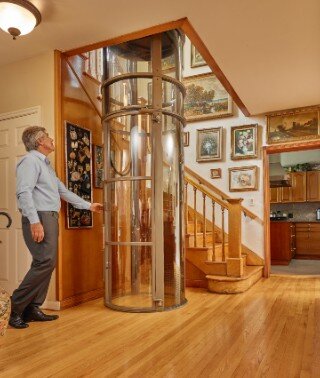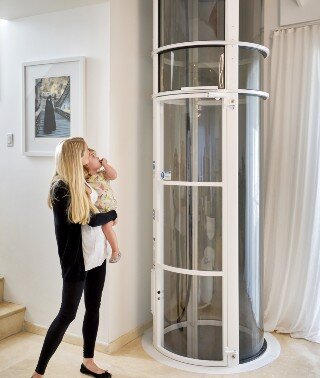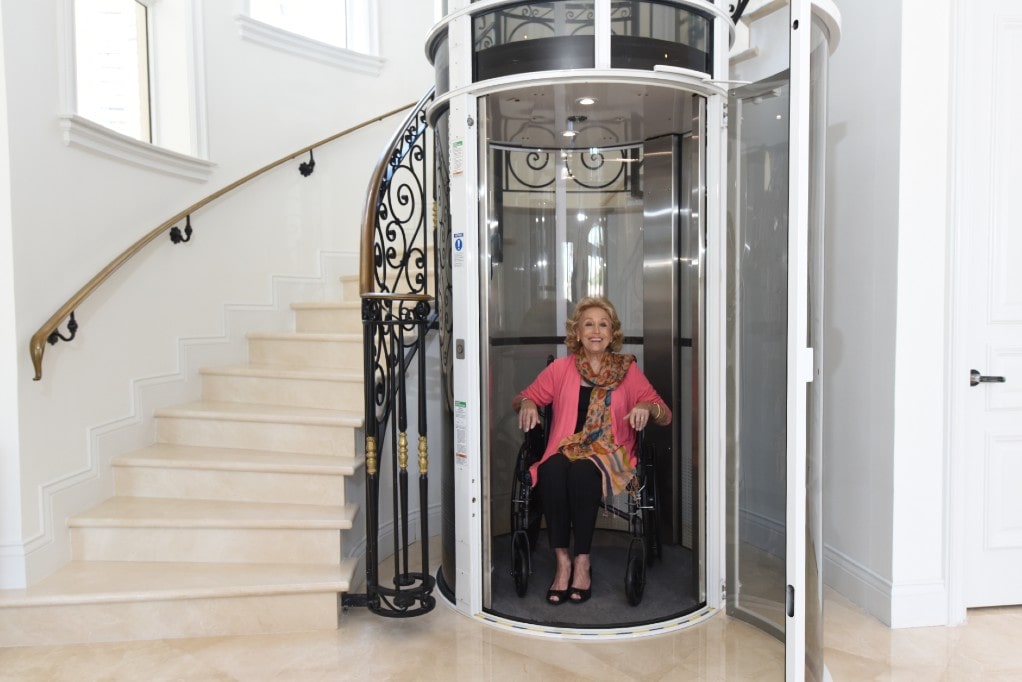Have you ever wondered how home elevators work and which type is best for your home or building?
If you’re considering a home elevator upgrade or just curious about your options, you’re in the right place.
You should know that choosing the right elevator isn’t just about convenience; it can enhance your comfort and accessibility.
In this blog, we’ll break down the mechanics of hydraulic models and compare them with modern pneumatic systems. By the end, you’ll have a clear idea of which type might suit your needs best.
Are you curious about other types of options? Check out our Types of Home Elevators for a broader look at what’s available.
What is a Hydraulic Elevator?
Hydraulic elevators are a type of lift system that uses hydraulic power to move the elevator car up and down.
They’re commonly found in low-rise buildings and residential properties due to their reliable performance and smooth operation.
These rely on a hydraulic pump and fluid to lift the car, making them ideal for settings where space for a traditional elevator shaft might be limited.
A fun fact to know about them is that they have been around for over a century, evolving from simple mechanical systems to advanced, more efficient designs.
Their development has made them a reliable choice for many residential and commercial applications today.
There are a few different types of them that you might encounter:
1. Conventional Hydraulic Elevators:
These use a piston inside a cylinder to lift the cabin. They require a pit at the bottom and a machine room at the top.
2. Hole-less Hydraulic Elevators:
These are designed for buildings with limited space and have a piston that moves within a telescoping tube, eliminating the need for a deep pit.
3. Roped Hydraulic Elevators:
Combining hydraulic and rope systems, these offer a smoother ride and are often used in taller buildings.

4 Models To Choose From
Are you looking for an in-home elevator? Simply pick your favorite below to learn more.

PVE30 - Home Elevator
Single Passenger Residential Elevator
Space-Saving Solution
Exterior Diameter
30 Inches
(750 millimeters)
Maximum Weight
350 Pounds
Rated: 1 Person
Per Use

PVE37 - Home Elevator
Two Passenger Residential Elevator
Flexible & Dynamic Lift
Exterior Diameter
37 Inches
(933 millimeters)
Maximum Weight
450 Pounds
Rated: 2 People
Per Use

PVE52 - Home Elevator
Three Passenger Residential Elevator
Wheelchair Accessible Lift
Exterior Diameter
52 - 11/16 Inches
(1,316 millimeters)
Maximum Weight
525 Pounds
Rated: 3 People
Per Use

The Cube - Home Lift
Two Passenger Residential Elevator
Affordable Alternative To Stairs
Exterior Diameter
52 - 11/16 Inches
(1,316 millimeters)
Maximum Weight
450 Pounds
Rated: 2 People
Per Use
How Hydraulic Elevators Work?
Hydraulic elevators operate using a straightforward yet effective system. Let’s break down how they work and what makes them a reliable choice.
Core Mechanism:
At the heart of hydraulic lifts are a few key components: hydraulic fluid, a pump, a motor, and a cylinder. Here’s how they all work together:
1. Hydraulic Fluid
This special oil or fluid is crucial for the system. It’s stored in a reservoir and helps to move the lift compartment smoothly.
2. Pump and Motor
The pump, powered by a motor, pushes the hydraulic fluid into a cylinder. This cylinder contains a piston that moves the cabin up and down.
3. Lifting Process
When the lift needs to move up, the pump pushes the hydraulic fluid into the cylinder. The fluid pushes against the piston, which in turn lifts the
4. Lowering Process
To lower the elevator, the hydraulic fluid is released back into the reservoir. Gravity helps bring the cabin down smoothly, while the system controls the flow of fluid to ensure a safe descent.
Safety Features:
Safety is a top priority with hydraulic systems.
Here are some of the key features designed to keep you secure:
1. Pressure Relief Valves
These valves prevent too much pressure from building up in the system, which could cause damage or malfunction.
2. Emergency Lowering Systems
In case of a power failure, these systems allow the hoistway to be safely lowered to the nearest floor, so you’re never stuck in an emergency.
3. Safety Brakes
These engage if there’s a malfunction or if the lift moves too quickly, ensuring it stops safely.
Power Source:
Hydraulic models run on electricity, which powers the motor and pump. While they do require a steady power supply, they are generally efficient in their energy use. The power consumption largely depends on the size of the elevator and how frequently it’s used. Hydraulic systems are known for their reliability and smooth operation, making them a popular choice for many buildings.
By understanding these basics, you can appreciate how hydraulic lifts offer a dependable and efficient way to move between floors, combining simplicity with robust safety features.
If you’re curious about the inner workings and want to learn more, check out this in-depth guide.
It breaks down the process in a way that’s easy to understand.
Comparison with Pneumatic Home Elevators
When it comes to choosing between hydraulic and pneumatic systems, understanding their differences can help you make an informed decision.
Working Mechanism:
Pneumatic lifts, also known as vacuum lifts, operate using air pressure. Instead of using fluid and pistons like hydraulic models, pneumatics rely on a powerful vacuum system to move the elevator car. Air is either sucked out or pushed in to move the car up or down.
1. Lifting Process
While the working mechanism of hydraulic lifts is quite different from the pneumatics, it uses fluid pressure to lift, and pneumatics create a vacuum above the platform to lift it and let air pressure below it bring the car down. This makes pneumatic technology more energy-efficient as they require less power, especially when descending since they mostly rely on gravity.
Design & Installation:
There are also significant differences in design and installation:
1. Design
Pneumatics are known for their sleek, futuristic design with a panoramic view. They have a cylindrical shape that fits easily into many home styles.
On the other hand, the hydraulic system is more traditional, requiring more space and often needing a machine room.
2. Space Requirements
Hydraulic lifts need more space due to their components, including the machine room and piston shaft.
Pneumatic lifts, however, have a compact design that doesn’t require a pit or machine room, making them ideal for homes with limited space.
3. Installation Complexity
Hydraulic models can be more complex and time-consuming to install because of the extra infrastructure needed.
Pneumatic systems, with their self-contained design, can be installed more quickly and with fewer modifications to your home.
Maintenance & Environmental Impact:
Maintenance and environmental impact are other important factors to consider:
1. Maintenance Needs
Hydraulic models typically require more maintenance because of the hydraulic fluid and moving parts. Over time, the oil in hydraulic systems can break down and need replacing, which adds to upkeep costs.
Pneumatics, on the other hand, have fewer moving parts and don’t use any fluids, leading to lower maintenance needs.
2. Environmental Impact
Hydraulic systems use oil-based fluids, which can pose environmental risks if not handled properly. The need for oil also makes them less environmentally friendly.
Pneumatic systems, however, use air, which is a clean and renewable resource, making them a greener option for environmentally-conscious homeowners.
By comparing these factors, you can see that pneumatic models offer some clear advantages in terms of design, installation, and environmental impact, while hydraulic models bring tried-and-true reliability and performance to the table.

Why Choose Pneumatic Home Elevators?
When it comes to selecting the right elevator for your home, pneumatic models, like the PVE30, offer several distinct advantages over traditional hydraulic systems.
Here’s why they might be the perfect choice for you:
Space-Saving Design:
Pneumatic models have a compact footprint and don’t require a machine room or a pit, making them ideal for homes with limited space. Their sleek, cylindrical design allows them to fit seamlessly into various architectural styles without taking up too much room.
Quick Installation & Lower Maintenance:
Unlike hydraulic models, which can take longer to install due to their complex systems, pneumatic units can be installed in just a few days. They also require minimal maintenance, as they don’t use oils or other fluids that could leak or degrade over time.
Environmentally Friendly:
Pneumatic residential elevators operate using air pressure, meaning they don’t rely on hydraulic fluids or other environmentally harmful substances. This makes them a cleaner, greener option for eco-conscious homeowners.
Modern & Stylish:
With their panoramic views and sleek design, pneumatic lifts add a touch of modern elegance to any home. They not only improve accessibility but also enhance the overall aesthetic appeal of your living space.
Choosing a pneumatic residential elevator means investing in a solution that combines practicality, sustainability, and style, making it a superior choice for modern homes.
Interested in learning more?
Discover how an Air Pressure Elevator works by exploring our detailed blog page.
Reach out to us for a consultation or a quote and let us help you make an informed decision!

Conclusion
To wrap up, we’ve explored how hydraulic elevators operate, highlighting their core components and safety features. We also compared them with pneumatic home elevators, noting the space-saving design, environmental benefits, and modern appeal of pneumatic options like the PVE30, PVE 37, and more.
As you consider upgrading or installing an elevator in your home, keep in mind the unique advantages of pneumatic systems. They offer a sleek, efficient, and eco-friendly solution that fits beautifully into modern living spaces. If you’re looking for a model that combines style with practicality, pneumatics might just be the perfect choice for you.
Ready to elevate your home with a stylish and practical solution?
Check out our blog page for more insights on Air-driven pneumatic lifts and how they can enhance your living space.
Contact us today for a consultation or a quote—we’re here to assist.
FAQs
Q. Is a hydraulic elevator safe?
Yes, they are safe as they come with multiple safety features like pressure relief valves and emergency lowering systems to ensure reliable operation.
Q. Are hydraulic lifts expensive to maintain?
Maintenance costs can add up over time, especially due to the need for regular checks on the hydraulic fluid and other components, but they are generally affordable.
Q. Is it possible to install a hydraulic hoistway at home?
Absolutely! It is possible to install them in homes, especially in low-rise buildings where there is space for a machine room.
Q. Are hydraulic models quiet?
They are quieter than some other types, but they may produce some noise during operation due to the pump and motor.
Q. What maintenance do hydraulic systems require?
They require regular maintenance, including checking the hydraulic fluid levels, inspecting the pump and motor, and ensuring the safety features are working properly.








